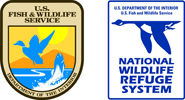Earth Science Week Classroom Activities
Connecting With Nature

Activity Source:
Adapted with permission by U.S. Fish & Wildlife Service
The “Blue Goose” has been the symbol of the National Wildlife Refuge System since it was first drawn by Pulitzer Prize-winning cartoonist J.N. “Ding” Darling, one of the greatest supporters of wildlife conservation in the 20th century.
President Theodore Roosevelt designated Florida’s Pelican Island as the first wildlife refuge in 1903. Now the National Wildlife Refuge System includes more than 550 refuges. National wildlife refuges are home to more than 700 species of birds, including many endangered species as well as an actual blue goose. Once thought to be a separate species, the blue goose is now recognized as a dark form, or “morph,” of the snow goose.
Naturalist and author Rachel Carson had a reminder for those who see the Blue Goose: “Respect it. It means that the land behind the sign has been dedicated by the American people to preserving, for themselves and their children, as much of our native wildlife as can be retained along with our modern civilization.”
Materials
One per student:
- One “Flat Blue,” copied from the image here or from http://americaswildlife.org/wp-content/uploads/2011/03/flat_blue.pdf
- Digital camera
- Paper and pen
Procedure
1. Select a national wildlife refuge or special outdoor place to visit with your family or class. This could be a new place or a favorite outdoor destination. To find a refuge close to you, see the map at www.fws.gov/refuges.
2. Take Flat Blue with you, along with your camera and writing materials.
3. Do something special at your destination. Perhaps you can take Flat Blue to a place where you have noticed changes since last year. Is the river or stream flowing quickly or slowly? Are there buds on the trees yet? What animals do you see? Where can animals find food?
4. Observe everything carefully. Write about what you see, hear, and even smell.
5. Take a photo of Flat Blue that shows your destination.
6. Back in the classroom, write your observations as a story about your adventure with Flat Blue. Choose one or two photos. Send the picture and the story of your adventure to americaswildlife@gmail.com with “Flat Blue” in the subject line. (If you want to be in the picture with Flat Blue, fill out the release form at http://americaswildlife.org/wp-content/uploads/2011/03/FWS_Photo_Release_Form1.pdf and send it with your story.
7. As an extension activity, learn more about the National Wildlife Refuge System by visiting www.fws.gov/refuges. Visit different pages to learn about endangered species, invasive plants and animals, sea level rise and other effects of climate change on refuges, ways to volunteer or work on refuges, and special events on refuges near you.
